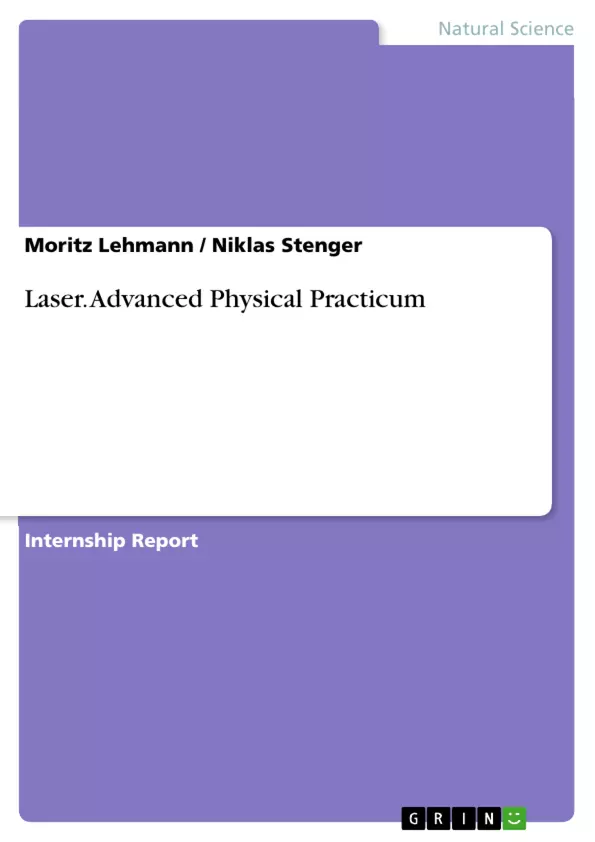Lasers are very commonly used in everyday life, e.g. in laser pointers, CD-Players or the lasers used in cash registers. But what makes lasers special and distinguishes them from other light sources? Which advantages do they have and what are their applications in physics?
In the experiment "Laser" in the Advanced Physical Practicum the task is to find out which mathematic coherences there are between parameters of the laser and to test how good they match the experimental observation.
Inhaltsverzeichnis (Table of Contents)
- Introduction/Motivation
- Laser medium
- Requirements for lasing
- Possibilities for energy levels
- Laser resonator
- He-Ne laser
- Fabry-Perot interferometer
- Dielectric mirrors
- Basic optical formulas
- Snell's law
- Fresnel equations
- Brewster angle
- Propagation using ray transfer matrix analysis
- Properties of M²
- Coherence
- Parameters of the practicum
- Autocollimation of the laser beam
- Transversal modes
- Gain factor and Brewster angle
- Axial modes
- Holography
- Gaussian laser profile
- Identification of the transversal modes
- Calculation of gain factor and Brewster angle
- Fabry-Perot-Interferometer
- Gaussian laser profile
- More questions
Zielsetzung und Themenschwerpunkte (Objectives and Key Themes)
The experiment "Laser" in the Advanced Physical Practicum aims to investigate the mathematical relationships between laser parameters and to compare theoretical predictions with experimental observations. The experiment delves into the fundamental principles of laser operation, examining the interaction between light and matter, and exploring the properties of laser light, including its high intensity, narrow frequency range, and coherent nature.
- The physics behind laser operation, including stimulated emission and population inversion.
- The design and function of laser resonators, focusing on the role of mirrors and their influence on laser output.
- The properties of laser light, such as its coherence, polarization, and spatial mode structure.
- The application of optical techniques, including Fabry-Perot interferometry and ray transfer matrix analysis, to characterize laser beams.
- The experimental verification of theoretical predictions regarding laser parameters and their influence on laser output.
Zusammenfassung der Kapitel (Chapter Summaries)
- Introduction/Motivation: This chapter introduces the concept of lasers and highlights their unique properties, particularly their high intensity and narrow frequency range. It explains the objective of the experiment, which is to investigate the relationship between laser parameters and experimental observations.
- Laser medium: This chapter discusses the requirements for lasing, emphasizing the need for a gain medium, population inversion, and a resonator. It explores different energy level configurations and explains how they influence laser operation.
- Laser resonator: This chapter describes the function of a laser resonator, focusing on its role in amplifying specific frequencies of light and creating standing wave patterns. It introduces the concept of longitudinal and transversal modes and discusses their properties.
- He-Ne laser: This chapter focuses on the He-Ne laser, a common type of gas laser. It explains the energy level transitions involved in its operation and the factors that influence the laser's bandwidth.
- Fabry-Perot interferometer: This chapter introduces the Fabry-Perot interferometer, a device used to analyze the spectral characteristics of light. It discusses the concept of finesse and explains how it influences the sharpness of the interference patterns observed.
- Dielectric mirrors: This chapter explains the use of dielectric mirrors in laser resonators and Fabry-Perot interferometers. It highlights their high reflectivity and how they are used to achieve high finesse.
- Basic optical formulas: This chapter provides a concise overview of fundamental optical formulas, including Snell's law, Fresnel equations, and the Brewster angle.
Schlüsselwörter (Keywords)
The key concepts and themes of this experiment include: lasers, stimulated emission, population inversion, laser resonators, longitudinal and transversal modes, He-Ne laser, Fabry-Perot interferometer, finesse, dielectric mirrors, Snell's law, Fresnel equations, Brewster angle, coherence, and laser beam characterization.
- Arbeit zitieren
- Moritz Lehmann (Autor:in), Niklas Stenger (Autor:in), 2017, Laser. Advanced Physical Practicum, München, GRIN Verlag, https://www.hausarbeiten.de/document/378240


